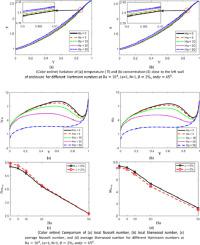当前位置:
X-MOL 学术
›
Int. J. Mech. Sci.
›
论文详情
Our official English website, www.x-mol.net, welcomes your
feedback! (Note: you will need to create a separate account there.)
Magnetic field effect on double-diffusion with magnetic and non-magnetic nanofluids
International Journal of Mechanical Sciences ( IF 7.1 ) Pub Date : 2021-02-01 , DOI: 10.1016/j.ijmecsci.2020.106085 Durgesh Kushawaha , Sushil Yadav , Dwesh K. Singh
International Journal of Mechanical Sciences ( IF 7.1 ) Pub Date : 2021-02-01 , DOI: 10.1016/j.ijmecsci.2020.106085 Durgesh Kushawaha , Sushil Yadav , Dwesh K. Singh

|
Abstract Magnetic nanofluids also are known as ferrofluids behave differently under magnetic field effect in comparison to non-magnetic nanofluids. The inclusion of magnetic forces term into the governing equations of magnetic media gives rise to the magnetohydrodynamics of magnetic nanofluids, also named as ferrohydrodynamics. This ferrohydrodynaimcs claims promising applications Rosensweig (1985)[1] with the field of new phenomena Berkovsky and Bashtovoy (1996)[2]. In the present numerical study, 2D laminar steady governing equations for double-diffusive natural convection with inclined magnetic forces for magnetic nanofluid Fe3O4/H2O and non-magnetic nanofluid Cu/H2O inside an exponentially heated and concentrated enclosure have been solved via finite-difference based stream-vorticity approach. Further, a comparative study has been conducted to analyze the impact of the magnetic field upon magnetic nanofluid Fe3O4/H2O and non-magnetic nanofluid Cu/H2O. Influence of various parameters namely; Rayleigh number (Ra), Lewis number (Le), buoyancy ratio (N), Hartmann number (Ha), nanoparticle volume fraction (ϕ), and magnetic field inclination angle (γ) on heat and mass transfer has been studied in detail. Heat and mass lines visualization techniques have been used for better insight of heat and mass transfer. The present work validates against experimental and numerical benchmark results and found to be in satisfactory acceptance. Total heat and mass transfers strengthen with the rise in inclination angle (γ) of magnetic field. It concludes that the effect of the magnetic field at lower value of Rayleigh number on overall heat transfer utilizing magnetic nanofluid Fe3O4/H2O is more effective than non-magnetic nanofluid Cu/H2O. Whereas magnetic field effect on mass transfer is more effective at a higher value of Rayleigh number. Percentage reduction in mass transfer is 10% has been found for Fe3O4/H2O, which is less than 12% of Cu/H2O nanofluid at higher value of volume concentration of nanoparticle.
中文翻译:

磁场对磁性和非磁性纳米流体双扩散的影响
摘要 磁性纳米流体也被称为铁磁流体,与非磁性纳米流体相比,在磁场效应下表现出不同的行为。将磁力项包含在磁介质的控制方程中产生了磁性纳米流体的磁流体动力学,也称为铁流体动力学。这种铁氢动力在新现象 Berkovsky 和 Bashtovoy (1996)[2] 领域的应用前景广阔,Rosensweig (1985)[1]。在目前的数值研究中,已经通过基于有限差分法求解了磁性纳米流体 Fe3O4/H2O 和非磁性纳米流体 Cu/H2O 的双扩散自然对流的二维层流稳定控制方程,该方程具有倾斜的磁力,用于指数加热和集中外壳内的磁性纳米流体 Fe3O4/H2O流涡流方法。更多,进行了比较研究,以分析磁场对磁性纳米流体 Fe3O4/H2O 和非磁性纳米流体 Cu/H2O 的影响。即各种参数的影响;已经详细研究了瑞利数 (Ra)、路易斯数 (Le)、浮力比 (N)、哈特曼数 (Ha)、纳米粒子体积分数 (φ) 和磁场倾角 (γ) 对传热和传质的影响。热量和质量线可视化技术已用于更好地了解热量和质量传递。目前的工作根据实验和数值基准结果进行验证,并被令人满意地接受。总热量和质量传递随着磁场倾角 (γ) 的增加而加强。得出的结论是,在较低瑞利数值下的磁场对利用磁性纳米流体 Fe3O4/H2O 的整体传热的影响比非磁性纳米流体 Cu/H2O 更有效。而磁场对传质的影响在瑞利数值越高时越有效。已经发现 Fe3O4/H2O 的传质百分比降低了 10%,在纳米颗粒的体积浓度较高时,其小于 Cu/H2O 纳米流体的 12%。
更新日期:2021-02-01
中文翻译:

磁场对磁性和非磁性纳米流体双扩散的影响
摘要 磁性纳米流体也被称为铁磁流体,与非磁性纳米流体相比,在磁场效应下表现出不同的行为。将磁力项包含在磁介质的控制方程中产生了磁性纳米流体的磁流体动力学,也称为铁流体动力学。这种铁氢动力在新现象 Berkovsky 和 Bashtovoy (1996)[2] 领域的应用前景广阔,Rosensweig (1985)[1]。在目前的数值研究中,已经通过基于有限差分法求解了磁性纳米流体 Fe3O4/H2O 和非磁性纳米流体 Cu/H2O 的双扩散自然对流的二维层流稳定控制方程,该方程具有倾斜的磁力,用于指数加热和集中外壳内的磁性纳米流体 Fe3O4/H2O流涡流方法。更多,进行了比较研究,以分析磁场对磁性纳米流体 Fe3O4/H2O 和非磁性纳米流体 Cu/H2O 的影响。即各种参数的影响;已经详细研究了瑞利数 (Ra)、路易斯数 (Le)、浮力比 (N)、哈特曼数 (Ha)、纳米粒子体积分数 (φ) 和磁场倾角 (γ) 对传热和传质的影响。热量和质量线可视化技术已用于更好地了解热量和质量传递。目前的工作根据实验和数值基准结果进行验证,并被令人满意地接受。总热量和质量传递随着磁场倾角 (γ) 的增加而加强。得出的结论是,在较低瑞利数值下的磁场对利用磁性纳米流体 Fe3O4/H2O 的整体传热的影响比非磁性纳米流体 Cu/H2O 更有效。而磁场对传质的影响在瑞利数值越高时越有效。已经发现 Fe3O4/H2O 的传质百分比降低了 10%,在纳米颗粒的体积浓度较高时,其小于 Cu/H2O 纳米流体的 12%。










































 京公网安备 11010802027423号
京公网安备 11010802027423号